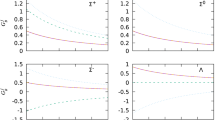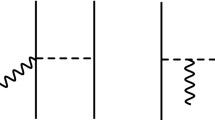Abstract.
We calculate the axial couplings gA8(0) and gA0(0) related to the spin of the nucleon in a constituent quark model. In addition to the standard one-body axial currents, the model includes two-body axial exchange currents. The latter are necessary to satisfy the Partial Conservation of Axial Current (PCAC) condition. For both axial couplings we find significant corrections to the standard quark model prediction. Exchange currents reduce the valence quark contribution to the nucleon spin and afford an interpretation of the missing nucleon spin as orbital angular momentum carried by nonvalence quark degrees of freedom.
Similar content being viewed by others
References
L.M. Sehgal, Phys. Rev. D 10, 1663 (1974).
Xiangdong Ji, Phys. Rev. Lett. 78, 610 (1997).
F. Close, Few-Body Syst., Suppl. 6, 368 (1992).
S.J. Brodsky, J. Ellis, M. Karliner, Phys. Lett. B 206, 309 (1988)
E143 Collaboration (K. Abe), Phys. Rev. D 58, 112003 (1998).
European Muon Collaboration (J. Ashman), Phys. Lett. B 206, 364 (1988)
We use the notation $q_{\mu} = (\nu, -\mathbf{q})$, where $\nu$ is the energy transfer and $\mathbf{q}$ the three-momentum transfer to the proton.
R.D. Carlitz, Int. J. Mod. Phys. E 1, 505 (1992).
In the following, we use the name ``QCD quark'' instead of ``current quark'' to denote the nearly massless quark fields appearing in the QCD Lagrangian.
A description in which the axial current contains only one-body operators is often referred to as ``impulse approximation''.
Due to the axial gluon anomaly of QCD, gluon spin contributions $\Delta G(Q^2)$ are admixed to the quark spin contributions in leading-order perturbation theory. As a result, the deep inelastic scattering experiments actually measure $\Delta q(Q^2) = \tilde{\Delta q} -\alpha_S(Q^2) \Delta G(Q^2)$, where $\alpha_S$ is the running QCD coupling constant. Thus, the $Q^2$-dependence cancels in the quark spin differences contained in $g_A(0)$ and $g_A^8(0)$ but remains in the quark spin sum $g_A^0(0)_{Q^2}$. This $Q^2$-dependence is very soft in the perturbative regime, but its evolution down to the confinement scale is not known.
From neutron $\beta$-decay one can extract $g_A(0)=1.2670\pm 0.0035$ pdg. Similarly, from the $\beta$-decay of $\Xi^-$-hyperon, and the assumption of $SU(3)$ flavor symmetry lipkin,flores one obtains $g_A^8(0)=0.588\pm 0.033$ (see ref. abe98 and references therein). Instead of the axial couplings $g_A(0)$ and $g_A^8(0)$, which govern the $\beta$-decay of octet baryons in the $SU(3)$ limit, the symmetric and antisymmetric flavor octet coupling constants $D$ and $F$ are often used. The relation between both notations is $g_A(0)= F+D$, and $g_A^8(0)= 3F-D$.
Particle Data Group (D.E. Groom), Eur. Phys. J. C 15, 1 (2000).
H.J. Lipkin, Phys. Lett. B 214, 429 (1988).
R. Flores-Mendieta, E. Jenkins, A.V. Manohar, Phys. Rev. D 58, 094028 (1996).
D. Barquilla-Cano, A.J. Buchmann, E. Hernández, Nucl. Phys. A 714, 611 (2003).
A. Buchmann, E. Hernández, K. Yazaki, Nucl. Phys. A 569, 661 (1994).
For a derivation of the Goldberger-Treiman relation from the PCAC condition see, T. Ericson, W. Weise, Pions and Nuclei (Clarendon Press, Oxford, 1988).
The pion-quark coupling constant $g_{\pi q}$ is fixed by the empirical pion-nucleon constant1.5pt $g_{\pi N}$ via $g_{\pi q}=\frac{3}{5}\, \frac{m_q}{M_N} \, g_{\pi N}$. With $g_{\pi N}= 13.1$, $m_q=313$MeV and $M_N=939$MeV, one obtains $g_{\pi q}=2.62$ and then from eq. (gaq), with $f_{\pi}=93$MeV, $g_{Aq}=0.77$.
A. Manohar, H. Georgi, Nucl. Phys. B 234, 189 (1984).
The fields $\Phi_1$, $\Phi_2$, $\Phi_3$ correspond to the isovector $\pi$ fields, and $\Phi_8$ ($\Phi_0$) to the isoscalar $\eta_8$ ($\eta_0$) fields from which the physical $\eta$ and $\eta'$ fields are constructed by mixing nuclth.
D. Barquilla-Cano, A.J. Buchmann, E. Hernández, Nucl. Phys. A 721, 429c (2003)
H. Yabu, M. Takizawa, W. Weise, Z. Phys. A 345, 193 (1993).
S. Weinberg, Phys. Rev. Lett. 67, 3473 (1991).
S. Peris, E. de Rafael, Phys. Lett. B 309, 389 (1993)
W. Broniowski, M. Lutz, A. Steiner, Phys. Rev. Lett. 71, 1787 (1993)
H. Leutwyler, Nucl. Phys. B (Proc. Suppl.) 64, 223 (1998)
Th. Feldmann, Int. J. Mod. Phys. A 15, 159 (2000)
M. Napsuciale, A. Wirzba, M. Kirchbach, Nucl. Phys. A 703, 306 (2002).
T.P. Cheng, N.I. Kochelev, V. Vento, Mod. Phys. Lett. A 14, 205 (1999).
S. Narison, G.M. Shore, G. Veneziano, Nucl. Phys. B 546, 235 (1999)
G. Morpurgo, Phys. Rev. D 9, 3111 (1989).
A.J. Buchmann, E.M. Henley, Phys. Lett. B 484, 255 (2000).
S.-L. Zhu, Phys. Rev. C 61, 065205 (2000).
M. Kirchbach, H.J. Weber, Comments Nucl. Part. Phys. 22, 171 (1998).
J.C. Peng, Proceedings of the LAMPF Workshop on Photon and Neutral Meson Physics at Intermediate Energies-LA-11177-C, Los Alamos, NM, Jan. 7-9, 1987, edited by H.W. Baer (Los Alamos National Laboratory, 1987).
Q. Zhao, Phys. Rev. C 63, 035205 (2001).
M. Dugger, J.P. Ball, P. Collins, E. Pasyuk, B.G. Ritchie, Phys. Rev. Lett. 96, 062001 (2006).
Although the evolution of $g_A^0(0)_{\mu^2}$ into the confinement region is not known we compare our quark model result with data taken at the renormalization scale $\mu^2=Q^2=3$(GeV/c)^2.
T.P. Cheng, L.-F. Li, Phys. Rev. Lett. 74, 2872 (1995)
A similar conclusion concerning the redistribution from quark spin to orbital angular momentum was reached in ref. cheng.
A.J. Buchmann, E. Hernández, A. Fäßler, Phys. Rev. C 55, 448 (1997).
A.J. Buchmann, E.M. Henley, Phys. Rev. C 63, 015202 (2001).
D. Singleton, Phys. Lett. B 427, 155 (1998).
Author information
Authors and Affiliations
Additional information
V. Vento
Rights and permissions
About this article
Cite this article
Barquilla-Cano, D., Buchmann, A.J. & Hernández, E. Axial exchange currents and nucleon spin. Eur. Phys. J. A 27, 365–372 (2006). https://doi.org/10.1140/epja/i2005-10270-4
Received:
Accepted:
Published:
Issue Date:
DOI: https://doi.org/10.1140/epja/i2005-10270-4




